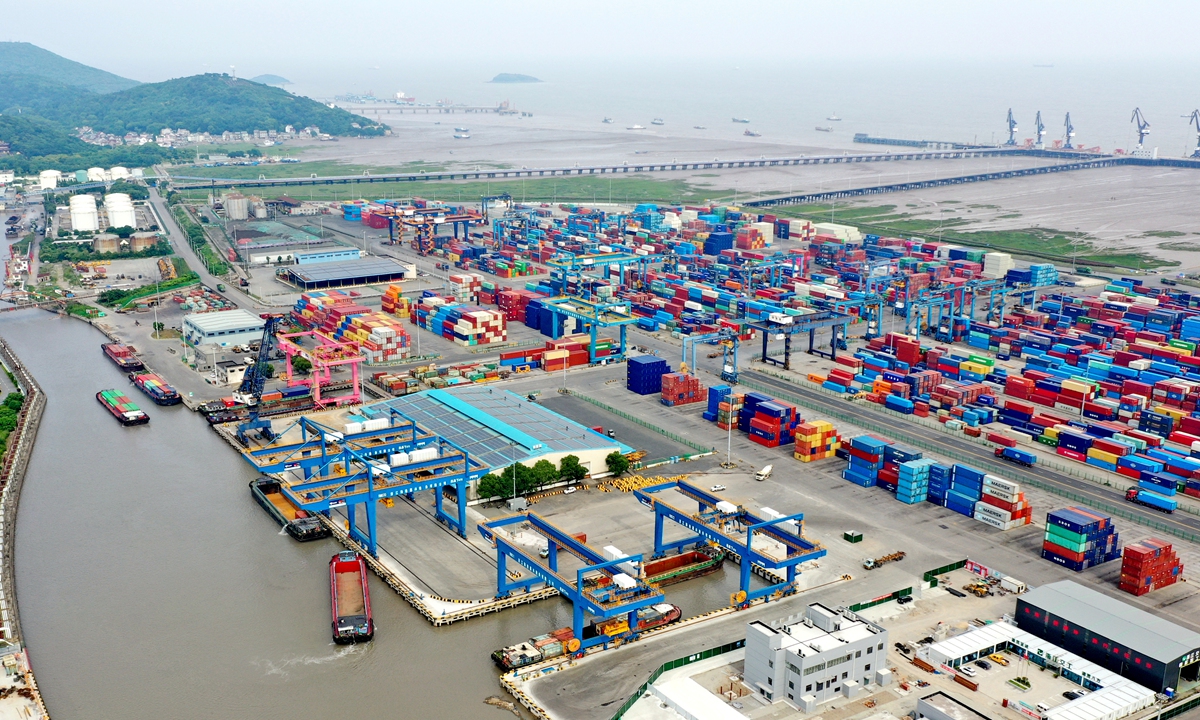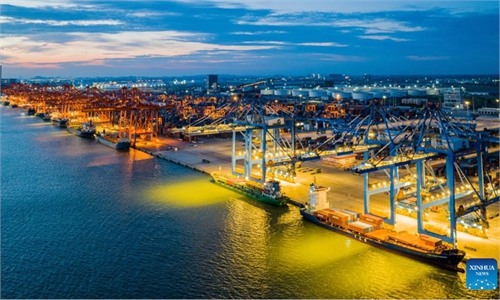Resilience in China’s foreign trade will still sustain Asia as the hub of global trade

Photo: Courtesy of Ningbo Zhoushan Port Group
For years, Asia has been the primary global trading hub. According to the United Nations Conference on Trade and Development (UNCTAD), in 2021, North America accounted for 10.13 percent of global export trade, Europe accounted for 37.16 percent, and Asia accounted for 42.97 percent. Therefore, while Asia is the most important stabilizer of global trade, China is the anchor of this stabilizer. In 1980, China accounted for only 3.6 percent of total Asian exports, and by 2021, China's share of Asian exports rose to 35.1 percent. China's foreign trade matters a lot to the stability of Asian trade and even of the global trade.According to the latest WTO estimates, as multiple shocks weigh on the global economy, world merchandise trade volumes are anticipated to lose momentum in the second half of 2022 and remain subdued in 2023 with only a 1 percent increase - down sharply from the previous estimate of 3.4 percent in April.
China's foreign trade in 2022 is also volatile. According to the General Administration of Customs of China, in the first seven months, China realized a year-on-year increase of 10.4 percent in total trade and 14.7 percent in export. In July alone, China's export reached a year-on-year growth rate of 17.9 percent. However, in August, China's export growth rate fell from July's 17.9 percent to 7.1 percent. Due to a slowdown of its GDP growth rate, worries of an "inflection point" and pessimism in China's trade resilience began to rise.
In fact, one cannot judge whether a country's trade has long-term resilience only by studying the data in one or two months. One also needs to look at the long-term development trends of international trade and the structural changes in this country's foreign trade. If a country can take advantage of the new trends of global trade and continue to gain new competitiveness and impetus, even if the trade data fluctuates due to short-term shocks, it won't affect the resilience of the long-term development sustained by its economic fundamentals.
From the perspective of the long-run development of global trade, at least two major trends are worthy of attention. First, since the outbreak of the 2008 global financial crisis, the growth of trade in goods has gradually lost momentum, while trade in services has entered a period of rapid growth. Besides, the share of goods trade based on labor-cost arbitrage has been declining over the last decade due to replacement of labor by automation worldwide.
Second, global value chains are being reshaped by both geopolitical and technological forces. As the report "Globalization in Transition: The Future of Trade and Value Chains" released by Mckinsey Global Institute in 2019 shows, "goods-producing value chains (particularly automotive as well as computers and electronics) are becoming more regionally concentrated, especially within Asia and Europe." Regional and even domestic production networks are gaining more strength due to the potential risks of global supply chains exposed by the outbreak of the COVID-19 pandemic.
The fact that China has a huge market of 1.4 billion people with a growing income, the world's most hard-working labor force who yearn for a better life, a large number of science and engineering students and engineers, the world's most efficient infrastructure and the most complete industrial system, and an ever-improving business environment, has provided solid economic fundamental support for China's foreign trade to continuously consolidate the industrial foundation, enhance the momentum and improve the market penetration. As a matter of fact, by actively conforming to the new trends in global trade development, China's foreign trade has become even more resilient in the process of long-term structural transformation. Let the data tell the truth.
First, China has gained new advantages in its transformation of trade patterns. As China continues to ease market access in the service industry and continuously promote high-standard economic and trade rules, China's service trade has grown rapidly and steadily. From 2010 to 2021, global services export increased by 52.6 percent, while China's exports increased by 119.9 percent, much higher than the 36.6 percent in the US, the 24.9 percent in Japan, the 67.5 percent in Germany and the 43.1 percent in the UK. In 2021, China's total services trade ranked second in the world for eight consecutive years, with its import ranking second for nine consecutive years. At the same time, new form of industry and new mode of business in China's foreign trade are also booming, with cross-border e-commerce particularly eye-catching. According to the Ministry of Commerce, since 2017, the scale of trade through cross-border e-commerce has increased by about 10 times in five years.
Second, China has enhanced its competitiveness in its transformation of product structure. While trade in services is growing rapidly, China's trade in goods has also performed very well. From 2010 to 2021, global merchandise export increased by 46.0 percent, while China grew by 113.2 percent, much higher than the 37.2 percent in the US, the -1.8 percent in Japan, the 29.6 percent in Germany, and the 74.7 percent in India; global merchandise import increased by 46.4 percent, while China increased by 92.6 percent, which is also much higher than the 49.1 percent in the US, the 10.8 percent in Japan, the 34.6 percent in Germany and the 63.6 percent in India. In the same period, with the upgrading of its industrial structure, China's share in global manufactured goods export increased from 14.9 percent to 20.9 percent, up by 6 percentage points. At the same time, export of high-tech manufacturing and equipment manufacturing grew rapidly. According to the World Bank database, China's high-tech exports rose from $474.35 billion in 2010 to $942.31 billion in 2021, up by 98.65 percent. Therefore, in the long run, China's manufacturing industry has not only withstood the test of the market in the process of global supply chain disruptions, but also continuously improved its competitiveness driven by the market forces and helped China's economy to move toward high-quality development.
Third, China has gained new impetus in its transformation of diversification. On the one hand, market diversification has achieved remarkable results, and China's "circle of friends" of foreign trade has continued to grow. Since the China-proposed Belt and Road Initiative (BRI) was launched, Chinese enterprises have stepped up their efforts to explore the new markets and the result is quite rewarding. From 2013 to 2021, the share of trade with countries along the BRI routes in China's total foreign trade increased from 25 percent to 29.7 percent. After the launch of the Regional Comprehensive Economic Partnership (RCEP), trade between China and ASEAN members continued to grow rapidly. China's imports and exports to ASEAN increased by 14 percent year-on-year, with a total value of 4.09 trillion yuan. During the same period, China's imports and exports with the other 14 RCEP member countries increased by 7.5 percent year-on-year, with a total value of 8.32 trillion yuan. China and ASEAN have become each other's largest trading partners, and the total trade volume with ASEAN members accounts for 15 percent of China's total foreign trade.
On the other hand, private enterprises have become the largest body driving the growth of China's foreign trade. In 2019, private enterprises surpassed foreign-invested enterprises for the first time and became the largest foreign trade entity in China. In 2021, the proportion of private enterprises in goods trade reached 48.6 percent, and in the first half of 2022, it further increased to 49.6 percent. This change reflects the improvement of the international competitiveness of Chinese capital and Chinese enterprises and the vitality of China's economy, and to a large extent, it is also the embodiment of the reform effect of letting the market play a decisive role in resource allocation.
According to the Survey Report on China's Foreign Trade Situation in the Third Quarter of 2022, released by the China Council for the Promotion of International Trade, foreign trade enterprises are currently facing multiple troubles such as shrinking external demand, insufficient orders in hand, high comprehensive costs, repeated flare-ups of the epidemic, and increased economic and trade frictions. It is particularly crucial to stabilize the overall performance of foreign trade at present. The fundamentals sustaining China's steady and long-term economic growth remain unchanged. And with more supportive measures and policies in place, China's foreign trade is still justified to expect a modest growth in the fourth quarter and continue to play an important role in driving China's economic growth this year.
As China is the world's second largest import market, its economic resilience and pursuit of a coherent opening-up policy will provide strong momentum for the stabilization and recovery of the world economy. As President Xi Jinping said at the 2022 edition of the Boao Forum for Asia, "No matter how the world will change, China's faith in and its commitment to reform and opening-up will not waver." Thus, China will continue to uphold high-level opening-up, fully implement the RCEP, actively promote accession to the Comprehensive and Progressive Trans-Pacific Partnership and the Digital Economy Partnership Agreement, and encourage the signing of high-standard free trade agreements with more countries and regions. In particular, as global value chains develop in the direction of regionalization, an open China will provide broader market opportunities for Asian countries and regions and better play the role of regional economic and trade stabilizer.
The author is a professor at the Institute of International Economy, University of International Business and Economics. opinion@globaltimes.com.cn

